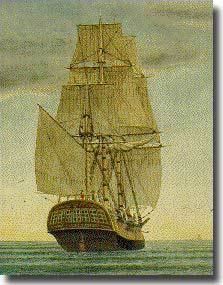Name Begum Shaw Fate Wrecked 1797 Propulsion Sail | Tons burthen 250 (bm) | |
 | ||
Sydney Cove was the Bengal country ship Begum Shaw that new owners purchased in 1796 to carry goods to Sydney Cove, and renamed for her destination. She was wrecked in 1797 on Preservation Island off Tasmania while on her way from Calcutta to Port Jackson. She was among the first ships wrecked on the east coast of Australia.
Contents
Voyage
The ship was built in Calcutta as part of the rice fleet, under the name Begum Shaw. She was bought in 1796 by the agency house (private trading firm) of Campbell and Clark to carry a cargo to Sydney Cove that consisted of various provisions, spirits and goods. The venture was speculative, meaning the goods had not been ordered by the colony, but rather were to be sold on arrival.
The new owners kept the ship's master, Gavin (or Guy) Hamilton, and she departed on 10 November 1796. She encountered heavy seas in December that started a leak. Further bad weather in January increased it, so that the pumps had to be manned continuously. In February, off the east coast of Tasmania, yet more heavy weather saw the leak gaining on the bailing efforts.
On 9 February 1797, with the water was up to the lower-deck hatches, putting Sydney Cove in imminent danger of sinking, Hamilton decided to ground the stricken vessel on the island now called Preservation Island, which is in the Furneaux Group, north of Tasmania. He chose a sheltered location so everyone was able to get ashore safely and most of the cargo was saved, too. He had the salvaged rum stored safely out of the crew's reach, on nearby Rum Island.
Trek north
A party of seventeen men set off on 28 February 1797 in the ship's longboat to reach help at Port Jackson, 400 nautical miles (740 km) away. This was led by first mate Hugh Thompson, and included William Clark the supercargo, three European seaman and twelve lascars. Ill fortune struck again and they were wrecked on the mainland at the northern end of Ninety Mile Beach. Their only hope was to walk along the shore all the way to Sydney, a distance of over 600 kilometres.
They had few provisions and no ammunition, and fatigue and hunger lessened their number as they marched. Along the way they encountered various aboriginal people, some friendly and some not. The last of the party to die on the march was killed by a man named Dilba and his people near Hat Hill. Those people had a reputation around Port Jackson for being ferocious. Matthew Flinders and George Bass had feared for their safety when they encountered Dilba the previous year.
In May 1797 the three survivors of the march, William Clark, sailor John Bennet and one lascar had made it to the cove at Wattamolla and, on 15 May 1797, with their strength nearly at an end they were able to signal a boat out fishing, which took them on to Sydney.
On the march Clark had noted coal in the cliffs at what is now called Coalcliff between Sydney and Wollongong. This was the second instance of coal discovered in Australia.
Salvage
The schooner Francis and the sloop Eliza were dispatched to Preservation Island to collect the people remaining there and salvage the ship's cargo. While waiting for rescue, the survivors had lived on the local short-tailed shearwaters, also called Australian muttonbirds, and built rough shelter for themselves. But the ship was damaged in May by heavy westerly gales, making it impossible to save her.
On the return journey the Francis and Eliza became separated and the Eliza was wrecked, with the loss of her crew and eight of the Sydney Cove survivors. The Francis made a further salvage voyage in December and again in January 1798. Matthew Flinders was aboard the third voyage, assigned to make geographical observations. He noted petrels and seals, and located and named the Kent Group of islands.
At the same time George Bass was on his whaleboat voyage following the coast of the mainland, and he had thought to make for the Sydney Cove to replenish his provisions but leaks in the boat prevented him setting that course. He did, however, encounter a group of escaped convicts marooned on an island. They, too, had been making for the ship with the false hope of refloating her and making good their escape.
Bass Strait
When the master of the Sydney Cove reached Sydney, he reported that the strong south-westerly swell and the tides and currents suggested that the island was in a channel linking the Pacific and southern Indian Ocean. The Governor of New South Wales, John Hunter wrote to Joseph Banks in August 1797 that it seemed certain the strait existed.
The salvage team also collected and preserved a wombat, which they forwarded to England for scientific observation, and observed colonies of seals. Soon after seal hunters were active in the area.
Today
The wreck was relocated in 1977, lying partly covered by sand in about 3 to 6 metres of water. Excavations have been made to recover artifacts and some timbers. The Queen Victoria Museum and Art Gallery in Launceston has a display of items from the ship, including the world's oldest bottle of beer. The survivors' camp was excavated in 2002. In 2016, new Saccharomyces and Brettanomyces strains of yeast genetically similar to those used in Trappist Ale were isolated from one of the 26 beer bottles recovered from the wreck 20 years earlier.
